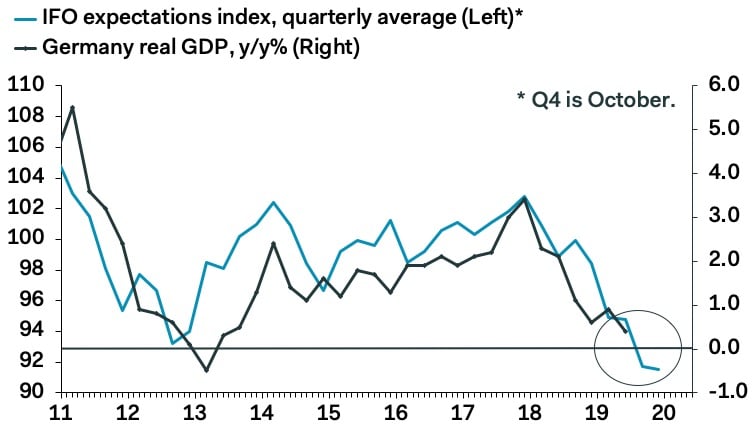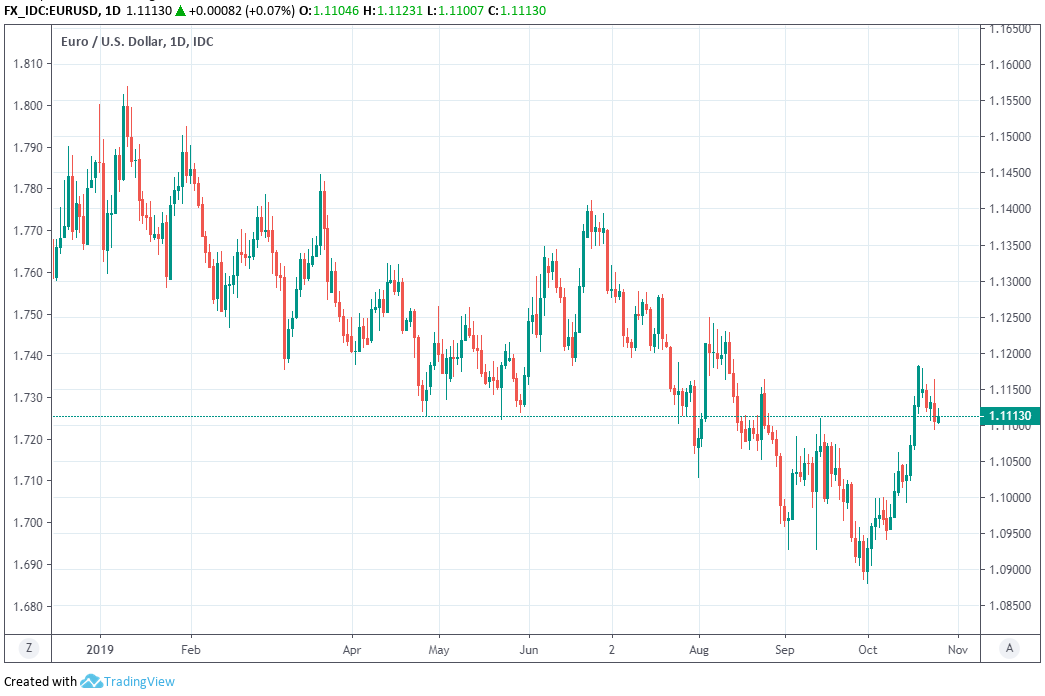The Euro-Dollar Rate: Upside Limited Even after Ifo Points to Stabilising German Economy
- Written by: James Skinner
-

Commerzbank HQ dominates the Frakfurt skyline. Image © Andre Douque, reproduced under CC licensing conditions
- Ifo reveals soft start to Q4 for German economy.
- But also highlights signs of stabilisation in outlook.
- But tariff and Brexit concerns could scupper upturn.
- ECB to remain a weight on EUR in absence of Fed shift.
The Euro crept higher Friday and was undeterred from its upward climb by the October Leibniz Institute for Economic Research (Ifo) survey, which suggested a soft start to the final quarter in Europe's largest economy but also revealed tentative signs of stabilisation.
Germany's Ifo index stood unchanged at 94.6 in October when the consensus had been for a decline to94.5, with improvement in the six-month outlook offsetting a deterioration in the current conditions component of the barometer. The institute says the slump in the manufacturing industry, a key driver of the broader downturn in the economy, has come to an end.
Manufacturers were less optimistic about their current situation this month but did become more positive in their views for the next two quarters, which is credited by the institute as stabilising the broader economic outlook. The outlook in the trade sector also improved, indicating that some of stabilisation could be related to the 'phase one' U.S.-China trade deal announced on October 11 and progress in the Brexit negotiations.
"The expectations gauge edged higher, to 91.5 from 90.9 in September, offsetting a dip in the current assessment gauge. This is traditionally bullish sign in this survey, but the evidence is very tentative at this point. Overall, the key message from the IFO is still one of slowing growth, and acute recession risks. Meanwhile, the details were mixed," says Claus Vistesen, chief Eurozone economist at Pantheon Macroeconomics.

Above: German Ifo correlation with real GDP. Source: Pantheon Macroeconomics.
The Ifo survey polls more than 7,000 German businesses, asking them to rate the relative level of current business conditions as well as the outlook for the next six months. It carries weight with investors and economists, more so than the ZEW survey, because of the particularly large sample size.
"Despite today's Ifo news, the German economy remains caught in the toxic mix of external uncertainties, the global manufacturing slowdown and homemade structural weaknesses. In fact, even though the jury is still out, it looks increasingly hard for the German economy to avoid a technical recession; that would require a strong rebound in economic activity in September," says Inga Fechner, an economist at ING.
Germany's Ifo index has fallen in 13 out of the last 16 months and is currently close to its lowest level since the financial and economic crisis of 2008-2009, with the fall having been driven by the disastrous impact President Trump's trade war has had on the export-driven manufacturing sector. That being said, chronic uncertainty over the likely outcome of the Brexit process, not to mention the impact that Federal Reserve (Fed) interest rate policy has had on the rest of the world, has also been at play.
"What is worrisome currently is the fact that the service sector seems to have lost its immunity against the manufacturing slowdown. Yesterday’s PMI services dropped to the lowest level in more than three years," Fechner says. "Looking ahead, high inventories and thin order books do not bode well for the manufacturing sector."

Above: Euro-to-Dollar rate shown at 4-hour intervals.
The rub for the outlook and Germany's economy is that responses used to compile Friday's index were received between October 7 and October 24 so they will have been influenced by both the U.S.-China trade accord as well as claims by UK Prime Minister Boris Johnson to have the numbers he needs to get his Brexit proposals through the House of Commons. And there's now uncertainty about how long the trade truce will last, while the UK is now headed for a potentially damaging general election.
"There might now be a bit of market relief that at least the Ifo data has not come in worse, and hence fixed income might sell off somewhat and the euro be supported. However, you could also argue that the expectations part of the Ifo might have been positively influenced by what looked like a Brexit deal earlier this month, only for it to slip away once again. In other words, better sentiment in the German corporate world might only be temporary," says Beat Siegenthaler, a macro salesperson at UBS.
It's possible the October upturn in the outlook component of the Ifo index soon dissipates. And it's no longer only the manufacturing sector that's troubling the German economy because IHS Markit PMI surveys revealed on Thursday, a surprise deterioration of the outlook for services companies too. Economists now fear that Germany's earlier manufacturing downturn has had an impact on other parts of the economy, one that is now becoming observable.
Germany is widely believed to have entered recession in the third quarter although official data is not out until 08:00 on Tuesday, 14 November. The government is now said to be expecting GDP growth of just 0.5% for 2019, down significantly from the 1.5% seen in 2018. And the German downturn is a big part of why Eurozone growth has fallen so sharply of late, as well as why the European Central Bank (ECB) has cut its deposit rate to a new low and set out to reopen its quantitative easing program.

Above: Euro-to-Dollar rate shown at daily intervals.
"Our Macro Ranking Scorecard Index (MRSI) has increased its short exposure. As we run MRSI on a dynamic weighting structure, EUR ranks poorly on growth, carry, yield curve and [fair value] factors. Meanwhile, MRSI has flipped long USD - the biggest weight in its trading portfolio - after leaning short a month ago. We think this lines up well with the US-centric event risks next week where the Fed should deliver a (fully priced) cut but likely signal a pause," says Mazen Issa, a strategist at TD Securities.
Europe's fragile economy is expected to keep the ECB's interest rates at or below their current record lows for a while yet so much about the Euro-to-Dollar rate's trajectory in the short-term will be determined by what the Federal Reserve does, until the Eurozone regains its earlier growth momentum. The Fed is widely expected to cut U.S. rates for a third time this year next Wednesday, although markets are also wagering heavily that it'll cut twice more after that as well, but analysts are less sure.
"The prospect for trade deals (US-China and Brexit) alongside soft US data has caused the dollar to weaken since early October. Risk appetite has broadly increased. At these levels, however, significant optimism has already been priced in," says John Shin, a strategist at Bank of America Merrill Lynch. "The trade war remains pivotal, and we continue to have a near-term EURUSD target of 1.08 for end-2019.We remain cautious in interpreting more recent positive trade developments."
Much like in Europe, American factories are struggling due to the fallout of the trade war and a strong Dollar, which has resulted from both Fed policy as well as the trade war, but the domestic side of the U.S. economy has been resilient. As a result, some analysts and economists are sceptical of the idea that the Fed will want to pre-commit itself to further easing as soon as next week, which could mean the greenback is in for a rebound and the Euro-to-Dollar rate likely to come under pressure again.
"There is some speculation that the Fed could even stand pat, and if realized, that would undoubtedly leave USD risks skewed topside going into the meeting. We do not think the Fed is willing to disrupt financial markets at this point, but it does animate the risks around going into the meeting, which are skewed topside for the USD," Issa says. "We think a combination of events through next week should reinforce this bias. 1.12 should be firm resistance for EURUSD."
Time to move your money? Get 3-5% more currency than your bank would offer by using the services of a specialist foreign exchange specialist. A payments provider can deliver you an exchange rate closer to the real market rate than your bank would, thereby saving you substantial quantities of currency. Find out more here.
* Advertisement









